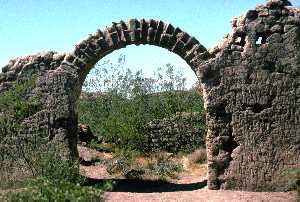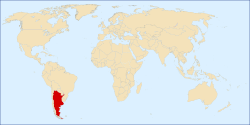National Park Lihue Calel
|
|
|

Area: 99 km²
Co-ordinated: 38°01.00'S, 65°32.00'O
Date of Creation: 1977
Administration: National administration of National Parks
Category IUCN: II
The National Park Lihué Calel, sometimes call Lihuel Calel has 9,901 has in the South center of the province of Pampas, Department Lihuel Calel. It was created in 1977.
It belongs to the fitogeográfica mount province of plains and plateaus where tussok predominates dry. The protected area preserves the "Mountain System" homónimo, with its historical values, cultural and ecological.
Cultural Values
Archaeological sites are conserved where the prehistoric original towns inhabited the region and they were related to the atmosphere of the mountain ranges. The Valley of Paintings shows "delayed rock art" of the region: representations of geometric reasons in colors red and black (2000 years aC.
The Mountain ranges of Lihué Calel (pleonasmo since in mapundungun lihué means life and calel mountainous area: Mountainous area of the Life), with the fresh water reserve, developed to a flora and specific fauna. And the atmosphere was taken advantage of by the original one from prehistoric times.
Those hunters and recolectores had: * seeds and fruits of the trees of Caldén and Chañar * guanacos, choiques and piches (armadillos). * rocks to make tools. * pigments to paint. * depressions and paredones to express its experiences. There are sites of the Park where those towns made art and buried their deads.
Until century XVIII the territory was inhabited by the ethnic group patagónida of genaken them (or gününakuna) called "puelche" (people of the east) by mapuche that into the mentioned century burst in from the present Chilean territory, the transculturación of guenaken them, its mapuchización, originated to the ethnic group of ranculche (people of canes), such towns inhabited this region, like stopping place of its displacements between the Mountain range and these territories of the provinces of Pampas and of Buenos Aires.
The toponymy of the gorge and the main valley take the name of one of their heads: Manuel Namuncurá. By the end of century XIX, the white occupation of these territories begins here, to the repairs of the mountain ranges, where there was fresh water, and some possibility of seeding and of harvesting, of constructing stone houses and of having animals was adapted.
Already the rest of "the Stone House", are of the times of the later colonization to the denominated Campaign of the Desert.
Orography, Flora, Fauna, Climate
The mountainous areas of Lihué Calel stand out originated makes 240 million years during the precámbrico from strong lava eruptions (at modern times the plutónica or volcanic activity is nonexistent in the zone), the worn away summits of these old 600 mountains arrive at msnm, with smooth slope in slopes towards the north, and steep in those of the south.
In the Park they dominate tussok and, thanks to the greater humidity, the thin mount espinozo, whose vegetation is of arbustales of jarillas, with small wood of caldén, piquillín, kills chilladora and incense or molle.
The mountain range of Lihué Calel has more humid areas, by the impermeability of the ground; there are small seasonal streams of autumn-spring, that infiltrate in sandy grounds.
Flora Thus, they appear small forests of caldenes with the small shrub bull shade: typical formation of the spinal one, that arises as spots in the mount. They are spp. of endemic plants of these mountain ranges: two daisies and one leguminosa. In the rocky terrains it appears one more a more humid flora: ferns, claveles of the air (epifitas on stones), and several cactaceous like the puelchana and teasels, pencas and the "traicioneras" (with very aggressive thorns).
In the rocky walls there is líquenes in yellow figures circular, orange and blackish. Fauna There are vizcachas, cuises, guanacos, maras ("patagónicas hares"), foxes, ferrets, pumas, red armadillos and lizards. Birds: martineta, gallito copetón, gray halconcito, yellow cardinal (in risk of extinction by captures to commercialize like domestic animal), buteos, jotes, owls, chimangos, calandrias, choiques ("ñandúes of the south"), occasionally cóndores, altogether count 150 species of native birds.
When they mature the fruits of caldén, flocks arrive from barranqueros parrots to eat their seeds. Tuco-tuco and armadillos like piche, live in caves to escape to the high temperatures. Climate It is warmed up barren, with rains between 100 and 200 mm, and marked thermal amplitude. The little precipitation gives to a dry climate with fort temperature difference between stations.

Mara or Patagonian Hare
Thus it produces a semi-arid atmosphere in the National Park; although the "Mountain ranges of Lihué Calel" or "Mountain ranges of the Life" generate a microclimate to retain rainwater, being moderated the temperatures in summer.
The access to the Park is by National Route 152, to 123 km to the southwest of the locality of General Acha and to 220 of provincial the capital Santa Rosa. The town closest is Puelches, to 39 km of the National Park. Strolls and Services Near the administrative area of the park is a camping with toilets.
Strolls
* Footpaths with interpretativa señaléctica
* Footpath "The Huitru": one begins in the camping and it ascends to the Hill of the Scientific Society. It shows Monte, their flora and fauna.
* Footpath "Valley of Paintings": 600 ms are crossed, having given to know the use the native ones, and it is arrived at eaves with cave paintings.
* Footpath "Namuncurá Valley": it begins in the camping and one rises the High Hill. It shows the characteristics of Monte. Ascent to the hill of Scientific Society (590 msnm, of little difficulty.
* Old helmet of the "Stay Santa Maria de Lihué Calel", who was of the family of Striking Luis until 1964, in which the Province of Pampas expropiara for tourism, and soon donated the Administration of National Parks. One suggests the visitors: - To consider the indications in the protected area, for the conservation of the area. - To enter with vehicle to low single speed and by the qualified ways. - it is not allowed to enter with any other type or firearms. - If it encamps and it generates sweepings, it returns with her. - It avoids to drive equipment of audio and horns. - Before any restlessness, it consults to guardaparque.
Contacts
* National Park Lihué Calel
* Post-office box 53
* General L8200 Acha
* The Pampas, Argentine Republic
* Telephones: 0054 (029) 5243 6595, 5243 2639
* Mail: to lihuecalel@apn.gov.ar
* Administration of National Parks
* Av. Santa Fe 690 C1059ABN Buenos Aires, Argentina
* Tel 0054 (011) 4311 6633, 4311 0303
* Mail: to informes@apn.gov.ar It also see:
* World-wide union for the Conservation








